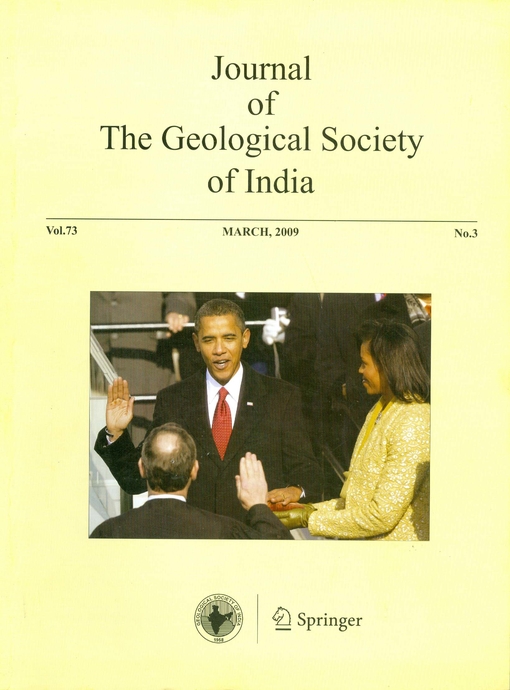A Note on Radioactive Riverine Placers Around Midtul, Bastar Craton, Central India
Keywords:
Radioactive Riverine Placers, Monazite, Zircon, Midtul, Bastar, Chhattisgarh.Abstract
Reconnaissance survey in the Midtul area (toposheet no. 65F/1; 18°52'30"N: 81°09'55"E) of the Bastar district, Chhattisgarh, revealed well-developed, 1 to 4 m thick riverine placers, derived from granitic terrain in the environs of the Mari River. The sediments comprise largely unconsolidated, cross-stratified gravels, sands, and silts, with low flat-topped surfaces which, at places, correspond to the morphology of terraces that are preserved on convex banks of the present day meanders, indicating their deposition by fluvial processes as channel bars. Available field data suggest deep-seated secular weathering of granites of the area, extensive reworking of such weathered products by fluvial processes, and their deposition as riverine placers in the vicinity of the streams draining the area.The granitic rocks of the area record radioactivity of 0.01-0.02 milli Roentgen per hour (mR/hr), with spots of higher radioactivity of 0.04-0.08 mR/hr, whereas riverine placers derived from them show radioactivity up to 0.25 mR/hr. Hand-panned polymineral concentrates from such placer deposits, analyzed by wavelength-dispersive x-ray fluorescence (WDXRF) spectrometry, showed 0.006-0.67 (n = 47; av. 0.092) % Y2O3 and 0.019-4.729 (n = 46; av. 0.834) % Ce2O3, with low values of Nb (41-467; n = 15; av. 197 ppm), Ta (115-598, n = 13; av. 230 ppm), and Sn (17-468; n = 14; av. 104 ppm). From the observed heavy mineral assemblage of monazite, zircon, ilmenite, epidote, hematite, and magnetite, as revealed by x-ray diffraction (XRD) studies, it is clear that the radioactivity is contributed by cerium, besides monazite (a phosphate of La, Ce, Th), and yttrium, possibly by zircon. Small amounts of niobium, tantalum, and tin are considered to be associated with ilmenite, epidote, and biotite. An occasional higher value of cerium (∼5% Ce2O3), together with restricted higher radioactivity, indicates only localized and uneconomic concentration of light REE-bearing mineral, monazite in isolated patches in such riverine placers.
Downloads
Issue
Section
Downloads
Published
How to Cite
References
BABU, T.M. (1994) Tin in India: Mineral Resources of India, Geological Society of India, Bangalore, 217p.
CROOKSHANK, H. (1963) Geology of southern Bastar and Jeypore from Bailadila to Eastern Ghats. Mem. Geol. Surv. India, v.87, 149p.
DHANA RAJU, R., ALI, M.A. and KRISHNAN, S. (Eds.) (2001) Special Issue on Beach and Inland Heavy Mineral Sand Deposits of India. Exploration and Research for Atomic Minerals, v.13, 159p.
GREEN, T.H. and PEARSON, N.J. (1987) An experimental study of Nb and Ta partitioning between Ti-rich minerals and silicate liquids at high pressure and temperature. Geochim. Cosmochim. Acta, v.51, pp.55-62.
MAHADEVAN, T.M. and DHANA RAJU, R. (Editors) (1999) Special Issue on Rare Metal and Rare Earth Pegmatites of India. Exploration and Research for Atomic Minerals, v.12, 171p.
MIALL, A.D. (1996) The Geology of Fluvial Deposits. Springer, 582p.
RAI, S.D., SHIVANANDA, S.R.,TIWARY, K.N., BANERJEE, D.C. and RAVI KAUL (1991) Xenotime-bearing inland placers in India and their beneficiation. Exploration and Research for Atomic Minerals, v.4, pp.77-92.
RAMACHAR, T.M., SHIVANANDA, S.R., DWIVEDY, K.K. and JAYARAM, K.M.V. (1983) The rare metal and REE occurrences in south Bastar, Madhya Pradesh. Geol. Surv. India Spec. Publ. No.13, pp.104-107.
RAMESH BABU, P.V., DWIVEDY, K.K. and JAYARAM, K.M.V. (1984) Geochemistry of tin-rich granites of Paliam and Darba, Bastar district, M.P. Proc. 5th Session Indian Geol. Congress, Bombay, pp.313-319.
SINGH, Y. (1991, 1992) Annual Report for the Field Seasons 1990-1991 and 1991-92. Unpubl. Rept. Atomic Minerals Division, Begumpet, Hyderabad.
SINGH, Y. (1998) Early Proterozoic rare metal and tin pegmatites near Kawadgaon, Bastar, M.P.: an example of vertical pegmatite zonation. Jour. Geol. Soc. India, v.51, pp.175-182.
SINGH, Y. (2002) Fluvial landform, mineralogical, and geochemical (Y, Ce, Nb, Ta, Sn) studies on granitic soil/alluvial deposits in the environs of Kawara and Nakti sub-basins around Amraoti, Bastar district, Chhattisgarh. Jour. Indian Assoc. Sedimentologists, v.21, pp.1-13.
SINGH, Y. (2007) Granitic soil yttrium-cerium geochemistry with xenotime concentrate upgradation around Darba, Bastar district, Chhattisgarh. In: A.M. Pophare and D.B. Malpe (Eds.), Recent Developments in Geology and Mineral Resources of Central India. Gondwana Geological Magazine Special Volume No.10, pp.173-178.
SINGH, Y. and RAI, S.D. (1992) Yttrium-europium-erbium geochemistry of granitic soils of Kunkuri area, Raigarh district, M.P., India. Jour. Geol. Soc. India, v.40, pp.347-358.
SINGH, Y. and SINGH, K.D.P. (1996) Mineralogical and geochemical studies on xenotime-bearing granites of Raikera area, Raigarh district, Madhya Pradesh, India. Jour. Atomic Mineral Science, v.4, pp.37-47.
SINGH, Y. and SINGH, K.D.P. (2001) X-ray mineralogy and ceriumyttrium-niobium-tantalum geochemistry of granitic soil from Muskel-Kawadgaon area, Bastar craton, Central India. Indian Minerals, v.55, pp.47-54.
VISWANATHAN, S. (1989) Wavelength-dispersive x-ray fluorescence spectrometry in exploration and research for atomic minerals. Exploration and Research for Atomic Minerals, v.2, pp.247-268.

 Yamuna Singh
Yamuna Singh


